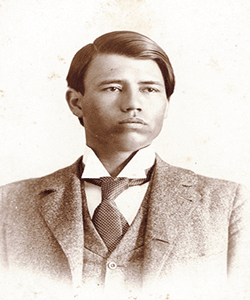In an 1893 issue of the magazine Young Men’s Era, Trinity student Joseph S. Maytubby wrote an article titled “Opportunities Open to Educated Indian Young Men.” In it, he urges Native-American men to place a high value on education. “We see the advantages of an education,” he wrote, “no matter to what tribe or race he belongs who bears the brain in which the wisdom is stored.”
Maytubby had particular expertise in this topic; he was a member of the Chickasaw tribe and would go on to be the first Native American to receive a degree from Trinity College. The story of how Maytubby and a small number of other Native Americans came to the college in the nineteenth century is extraordinary.
A decade before Maytubby’s arrival, the Cherokee Industrial School was established at Trinity College when it was still in Randolph County. Trinity was in serious financial straits, and the Bureau of Indian Affairs was pursuing a plan of training for Native-American children, mostly boys. (*1) As part of this effort, Trinity received a stipend for each student enrolled.
Beginning in the 1883-84 school year, a group of around twenty Native-American boys and young men attended Trinity. (*2) All were members of the Eastern Band of the Cherokee from the towns of Qualla Town and Cherokee in western North Carolina. Ranging in age from eight to eighteen, they were offered a curriculum intended to teach them about farming and other industrial skills rather than the liberal arts.(*3) Little of their experience was recorded (*4), so it is not known how much these students might have interacted with the Trinity students. We do know that at least two returned after their first year and attended the preparatory school at Trinity. The school petered out in 1887.
Maytubby arrived at Trinity from Indian Territory (now Oklahoma). He had attended a school for Indian students, Wapanucka Institute, run by Trinity alumnus James J. Scarborough. In 1889, Scarborough wrote to Trinity President John Franklin Crowell, telling him: “I have seen the Superintendent of the [Chickasaw] nation in regard to sending students to Trinity as the nation pays the college expenses when her young men go. He says there are no more that they wish to send to college now but when they do have some he will consider my college. They have been sending most of their young men to New York. We have some very fine students here but more who are now ready for Trinity.”
Maytubby entered Trinity three years later, in 1892—the same year that Trinity opened in Durham. He was, by all accounts, an extraordinary student. He was president of the Hesperian Literary Society, managed the “Literary Notes and Reviews” section of the Trinity Archive literary magazine, played football, and won the Wiley Gray Medal at his commencement in 1896, an honor given to the graduate who delivered the best oration of the class. A second student from Indian Territory, Benjamin Franklin Harrison, was just one year behind Maytubby. Of both Choctaw and Chickasaw descent, Harrison served as the business manager of Trinity Archive and wrote an article for the publication advocating for higher standards for public schools. He graduated in 1897.
Both men returned to Oklahoma and enjoyed successful careers. Harrison established a prosperous farm and was an active participant in local and state government, including as a representative in the Oklahoma State Legislature and as secretary of state for Oklahoma. Maytubby continued his education at the University of Texas after graduating from Trinity, and then practiced law in Oklahoma. After eight years, he retired from law and established a large farm. Like Harrison, Maytubby participated in politics and was elected the first mayor of Tishomingo, Oklahoma.
The history of Native-American students at Trinity and Duke stretches back longer than one might imagine, and there is still much work to be done to understand the experiences of these early students, as well as those who followed in their footsteps.
1*: For more information about the disturbing history of residential schools, see Education for Extinction: American Indians and the Boarding School Experience by David Wallace Adams (Lawrence, KS: University of Kansas Press, 2020).
2*: It is unlikely that attendance was voluntary.
3*: The Cherokee Industrial School was intended to suppress Cherokee culture and westernize the children.
4*: The records that document this period in the Duke University Archives are largely from the white administrators' point of view. However, Nora Chaffin's history of Trinity College describes a difficult and disorienting experience for the Cherokee students, with several running away to try to return home. The University Archives has compiled a research guide about Trinity’s Cherokee Industrial School.
Gillispie is the university’s archivist. She would like to thank senior Kyle Francis, whose historical project on Native Americans at Trinity informed this article, and junior Amber Hall and the members of the Native American Student Association, whose interest in the topic inspired additional research.

Share your comments
Have an account?
Sign in to commentNo Account?
Email the editor